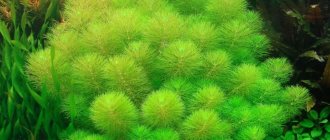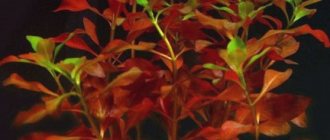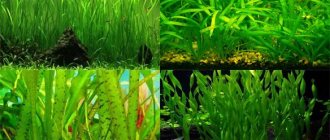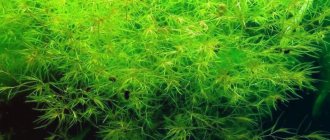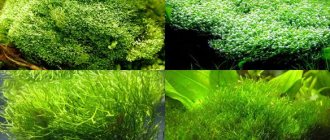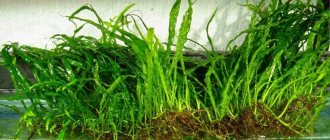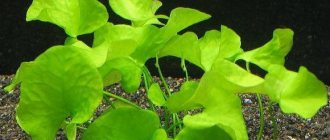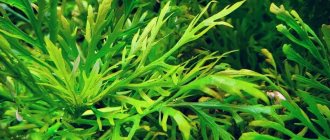Healthy and beautiful Aponogeton is the pride of many aquarists. The plant has high decorative properties and is easy to care for. However, there are some very beautiful views. Caring for which will be more difficult. A semi-aquatic plant with considerable size, unusual appearance and high endurance is especially valued by beginning aquarists.
General information and morphology
Underwater grass has extraordinary attractiveness. Many subspecies differ from each other in size, foliage color, degree of corrugation and “waviness” of the leaf plate.
Aponogeton - the most popular underwater grass
Habitat
Aponogeton belongs to the Aponogeton family, grows both in the warm waters of standing reservoirs and in the waters of fast-flowing rivers of East Africa and the adjacent island. Madagascar, India, Indochina, northern Australia. The plant genus includes 57 species, 11 of which are old residents of the Comoros Islands and Madagascar.
At home, the easiest to grow are those from Asia, and the most demanding is the grass native to Africa and Madagascar.
Interesting Facts
Residents of tropical countries consider Aponogeton to be an aquatic hawthorn. This is explained by the fact that its rhizome contains a large amount of starch. The local population eats the rhizome both baked and boiled.
Today, Aponogeton is widely used as aquarium decoration. However, few people know that people began to grow this plant back in the 80s of the 18th century. In addition, it has been naturalized in many reservoirs of Western European territories.
Content
When planning the landscape of your aquarium, you should take into account the large size of the plant. It will look great in tall containers and in home ponds. They plant it on the sides, thereby decorating the background. In a small vessel, this vegetation also looks impressive, but remains stunted, but no less beautiful.
Some varieties of aponogeton go into suspended animation, while others grow year-round.
Growing this flora in an aquarium requires compliance with certain maintenance conditions.
Aquarium
Ideally, such a giant would need a capacity of at least 150 liters. Only in such conditions can the bush grow into a truly attractive beauty. In conditions of small volume, the flower will remain stunted and will not show all its decorative properties.
For aponogeton you need an aquarium of at least 150 liters
The aquarium must be equipped with a good filter that will purify the water and an aerator that enriches it with oxygen. A compressor is also installed to help get rid of organic waste and prevent siltation.
Recommendations
It is preferable to plant Aponogeton ulvoides in a large aquarium - overgrown leaves can take up a lot of space. Overall it looks good in the middle and background to create a tropical background. Before planting, it is recommended to inspect the tuber and cut off any dying parts, if any. The tuber should not be completely buried in the ground. Moreover, in old silted soil the tuber may not have enough oxygen, so you need to leave a third or even more above the soil.
Popular types
Of the many varieties of aponogetonaceae, not all are suitable for placement in home aquariums.
Aponogeton undulatus (viviparous)
The most famous specimen comes from India. The leaves of the representative are long, translucent, soft green in color with a wavy structure. With a high degree of lighting intensity, it reveals all its decorative properties. Does not tolerate partial shade, in which the leaf blade straightens and the bush loses its beauty.
Aponogeton wavy - the most popular type
Aponogenton undulates is grown in soil enriched with microelements, soft water at a temperature of 22-27 degrees Celsius.
When it gets cold, Aponogeton viviparous drops its leaves and rests until favorable conditions arise.
The wavy variety has another name - “livebearer”. The fact is that the flower independently forms new daughter bushes. Arrows with a small knot are thrown out from the mother plant. From this nodule a new root tuber is formed, from which fresh leaf petioles soon sprout. As the tuber grows, the mother arrow rots, and under its weight the young bush sinks to the bottom, where it successfully takes root.
Aponogeton rigidifolius
The most undemanding representative of the family comes from Fr. Sri Lanka. Compared to other relatives, it grows well in water of increased hardness. It grows for a long time and in captivity grows no higher than 50-60 cm.
The leaf blade is long and narrow, the wavy edges are weak. The color saturation varies depending on the type of lighting (natural or artificial). Like all aponogetonaceae, it loves mineral supplements. Propagated by dividing the rhizome with the obligatory leaving of a living bud on each separate part. Subsequently, the growing season of a new bush begins from each of them.
Aponogeton rigidifolia - the most unpretentious species
Aponogeton crispus
Aponogeton curly red is also native to the island. Sri Lanka. An unusually beautiful shrub with jagged leaves along the edges, creating the impression of “curls”. They are distinguished by a large number of subspecies with a range of colors from red to blue.
The growing season of Aponogeton crispus continues all year round; there is no dormancy period in Crispus. Grass is capricious and demanding. Prefers warm water with a slightly acidic or alkaline reaction at a temperature of 25-27 degrees. Due to the increased temperature of the contents, fluid changes are carried out very often.
Aponogeton crispus tolerates light shading well, but at the same time loses its decorative effect: the “curl” straightens and the color becomes dull.
It reproduces both by dividing the tuber and by seeds.
Aponogeton curly prefers warm water
Aponogeton distachyon
It comes from South Africa, so it prefers a warm habitat, calm, standing bodies of water with bright light. The leaves are wide, pale green, up to 60 cm long.
The bush reacts positively to mineral fertilizers and prefers soil saturated with microelements.
It reproduces either as a “live-bearer” - by throwing out arrows with nodules - or by seeds. In winter, in a suitable environment, Aponogeton distachyon begins to flower, which lasts about 3 weeks. The bicornuate flowers have a pleasant scent.
After flowering, the fertilized grass seeds are ready to begin a new life.
Aponogeton two-spikelet - prefers fertilized soil
Aponogeton ulvaceus
A large variety that prefers a spacious place of residence. Aponogeton ulvaceus appeared on the island of Madagascar. A distinctive feature of the ulvoid shrub is its long (up to 70 cm) light green, coarsely wavy leaves, on which a mesh pattern of veins is clearly visible.
The optimal habitat parameters are:
- hardness - below 8 (in a harsh environment, the leaves of the plant die quickly);
- temperature – 22-26 degrees;
- acid-base environment - slightly acidic;
- lighting intensity is high.
Lightly silted soil is used as a substrate.
Ulvaceus “goes into hibernation” twice a year. Having shed its foliage, the tuberous root rests for 2-3 months after abundant flowering. During the “sleep” period, the roots are removed and stored in damp sand or left in an aquarium at a temperature no higher than 22 degrees so that they do not rot. At the end of the dormant period, the tubers can be divided into parts and rooted.
Under favorable conditions, the flower produces spike-shaped inflorescences one after another. If pollination is successful, seeds are one of the ways the variety reproduces.
Aponogeton ulvoides – loves a spacious place of residence
Madagascar Aponogeton (Aponogeton madagascariensis)
The Madagascar representative is the most beautiful and unusual of all relatives. Aponogeton madagascariensis lives in fast-flowing bodies of water on the island of Madagascar.
The peculiarity of its growth determined its appearance. The leaves of the grass grow up to 50 cm and can be either green or red. They do not have soft tissue, but consist only of veins, so that the stormy flow of the river does not injure the leaf plate. In this regard, even at home, this species can only exist in clean water without unnecessary impurities. If you do not replace it regularly, the plant dies very quickly.
The grass is picky about lighting - an aquarium with the Madagascar variety should never be placed in a place where it receives sunlight.
Aponogeton Madagascaris - the most beautiful and unusual species
Aponogeton elongatus
The largest representative of the family comes from Australia. The shrub is not in wide demand due to its gigantic size (the length of the bright green wavy leaves reaches 150 cm). Most often, this representative of the flora is planted in artificial reservoirs.
Aponogeton elongatus prefers soft water with a temperature of 24-26 degrees, which must be changed weekly.
Due to the fact that the root system is very powerful, well-silted soil up to 7 cm thick is suitable for the plant. To form a beautiful bush, bright natural light is required.
The species reproduces, like most other aponogetonaceae, by dividing the tuber at the end of a weak dormant period, or by artificially pollinated seeds, if the bush can be flowered.
Aponogeton elongata - the largest representative of the family
Aponogeton boivinianus
It differs from others in the pattern of the leaf plate - several parallel veins run along the entire leaf. The shrub grows up to 60 cm in height, so it is planted in large containers.
When unfavorable conditions occur, the bovine tree sheds its leaves. In this case, the root tuber is transplanted into cold wet coarse sand (15-20 degrees). After some time, the root will begin to vegetate again.
Propagating bovine is quite difficult and can only be done by experienced aquarists.
Boivina aponogeton grows up to 60 cm
Aponogeton floating (Aponogeton natans)
In floating aponogeton, the foliage is not located in the water, but on its surface. Nathans is most suitable for arranging ponds, small artificial home reservoirs.
The representative with long wavy soft green leaves is absolutely unpretentious and can live in an environment of any acidity and hardness.
Aponogeton floating - an absolutely unpretentious species
Aponogeton capuroni
Kapuroni is one of the most cold-loving relatives. The favorable temperature for its growth is 16-25 degrees, hardness – 6 dH, acidity – 7 pH. Fluid changes are performed weekly.
The relief structure of small leaves (10-20 cm in length) and short stature make it one of the most popular aponogetons in aquarium circles.
Aponogeton capuroni - the most cold-loving species
Priming
When planted in old soil, the plant does not require any additional feeding; the natural siltation of the substrate will be sufficient. It is advisable to add a small amount of clay and peat, as well as a little charcoal, to the new soil. Too much siltation harms Aponogeton - during the growing season this can cause rotting of the root system, which will most likely lead to the death of the plant. However, during the same growing season, fertilizing with mineral fertilizers is highly recommended. Coarse sand or small pebbles are suitable as a substrate. The substrate layer should be at least 4-5 cm.
Reproduction and planting
Reproduction of aponogetons is possible in several ways.
Reproduction using arrows
Some types of aponogetons (for example, wavy), under suitable conditions, reproduce by throwing out daughter shoots from an adult bulb. At the end of such an arrow a small knot is formed, which over time turns into a tuber of a new bush. As the daughter bushes grow older, the mother shoot dies off, and the tuber, with an increase in mass, sinks to the bottom under its weight. In fertile soil, young grass quickly takes root, forming its own root system and fresh, young foliage.
Propagation by rhizome parts
To get a new bush, the rhizome of an adult aponogeton is carefully divided into several parts, leaving a growth bud on each of them. The sections are carefully treated with charcoal to avoid rotting. Tuber pieces are planted in fertile, but not silted soil. After some time, a new bush will appear from the dormant bud.
Sometimes it happens that a new specimen develops independently from dormant buds. In this case, the “baby” is allowed to gain strength, then carefully separated from the main tuber and planted.
Tuber pieces are planted in non-silted soil
Propagation by seeds
Many members of the family begin to bloom when suitable conditions arise. The bush throws out arrows with spike-shaped inflorescences rising above the surface. To allow pollination, a distance of at least 6 cm should be provided between the surface of the liquid and the lid of the container. In addition, hot lamps should be abandoned and air circulation should be ensured in the air space. Otherwise, the flowers of the plant may be burned by hot air, and without ventilation, the pollen will stick together due to moisture.
After the “spikelets” appear, the flowers must be pollinated. Self-pollination is ineffective, so the process is carried out manually. Using a brush, the pollen is carefully transferred from one inflorescence to another.
Aponogeton flowers must be pollinated by hand
After pollination, the seeds are germinated in sand mixed with silt. The substrate is filled with water, but not higher than 1 cm from the surface. For shoots to appear, good lighting and a suitable ambient temperature (26-28 degrees) are required. As the shoots grow, the water level rises.
The young plants are transplanted to a permanent place when 3-4 true leaves appear.
Spreading
Under natural conditions, Aponogeton ulvoides grows in Madagascar. It lives in both standing and flowing water bodies. Usually completely covered with water.
Uses of aponogetone
The main purpose of most aponogetons is to decorate aquariums. Given its size, the flower is perfect for decorating the backdrop or planted on the sides.
Some types (for example, elongated or double-spikelet) are an excellent decorative element for garden ponds and small artificial reservoirs.
The livebearer is perfect for decorating an aquarium in the Dutch style. Its soft green wavy leaves contrast well with the bright foliage of other aquarium flora.
Despite all the decorativeness and attractiveness, aquarium designers do not like to use this flora for decoration. This is due to the large size of the flower, as well as its ability to shed foliage a couple of times a year.
The main purpose of aponogeton is to decorate aquariums
Description
This plant belongs to the family of the same name, and its natural habitat is impressive. These are mainly states washed by the Indian Ocean. That is, these are South Africa, India, Australia, Indonesia and many islands. The reservoirs are also quite diverse. These are various rivers, swampy ponds in forests, lakes, ponds, etc.
Aponogeton is distinguished by long leaves and small stems, if we talk about the underwater form. When the bush grows to the surface, the leaves become oval and stronger.
This plant is particularly hardy. If an unfavorable time comes for it, then it sheds its leaves, leaving only a massive tuber and roots, from which it feeds, and only after changing the situation to a more suitable one will it begin to produce leaves again.
It is interesting that this type of underwater flora can be kept both in an aquarium and in a small open reservoir. That is, it is suitable for decorating house ponds and can even easily winter in them without harming itself. The main condition is sufficient depth so that the bushes have somewhere to grow and hide from the cold.
Aponogeton is a hardy aquarium plant with an unusual appearance.
Lifehacks and tips for aquarists
Fans of these bushes have their own secrets for growing and improving their decorative qualities:
- Most varieties die when exposed to direct sunlight, so it is better to shade the aquarium with small floating plants.
- To illuminate the aquarium, not only overhead lamps are used, but also side ones.
- Shrubs are optimally planted in soil that contains many roots of various vegetation.
- After the leaves fall, the flower can be stimulated with the hormone Gibberellin by immersing the bulb in it for a couple of hours.
- If brown spots appear on the leaf plate, you should stop mineral fertilizing. This phenomenon indicates their excess.
- A good stimulator of aponogeton growth is to place the tuber in a plastic bag, which is put away in a dark place for a day. After such an “overnight”, the tuber is returned home, having renewed the water in the aquarium by 1/3.
- To avoid depletion of the crispus plant, which grows throughout the year, it is recommended to periodically remove aponogeton from the water and dry its tuber.
- Systematically you need to siphon the aquarium soil, since this type of flora does not tolerate heavily silted substrate.
Aponogetons are a popular flora of water bodies. Thanks to their attractive appearance, they are a natural decoration for both garden ponds and the interior decoration of aquariums. Representatives of the family get along well with other plants and demonstrate good compatibility with fish. With proper care and maintenance, underwater grass will regularly delight the owner with young shoots and flowering.
Have you grown such a plant in your aquarium or pond? Share life hacks with beginners in the comments.
Conditions
During periods of aponogeton growth, it is recommended to maintain the water temperature at 22-26 ° C; at other times, a slight deviation in both directions is allowed. The water should be soft, hardness no more than 8 °, with a neutral or slightly acidic reaction. Bright light is one of the prerequisites for the good development of this plant. The power of fluorescent lamps should be from 0.5 W/l, incandescent lamps - from 2 W/l. Daylight hours are from 12 to 14 hours. Constant filtration and frequent water changes are required - at least once a week.
Features of aponogeton boivinianus
At the beginning of spring, the bush sheds its leaves. This is a normal process that is associated with the growing season. The rest period lasts several weeks. If you dig up a tuber and keep it in cool water (at least +20°C) for about 2 months, and then bring the temperature to optimal values and provide bright light, the rosette will begin to grow again, and the bush planted in the aquarium will bloom.
To limit too rapid growth of the grass and prevent depletion of the tuber (for example, in a warm-water aquarium with fish, where there is a lot of organic matter), the bush is dug up, slightly dried or the roots are cut to ¼ of the length.

